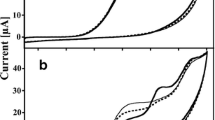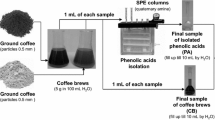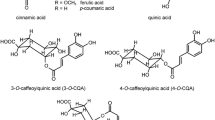Abstract
Antioxidant activities and major antioxidants were investigated in the methanolic extracts of roasted and spent coffee to evaluate the feasibility of spent coffee as a source of functional ingredients. Phenolic compounds, such as gallic acid, protocatechuic acid, and chlorogenic acid, and nitrogenous compounds, including trigonelline and caffeine, were identified. Caffeine was the most abundant compound, followed by chlorogenic acid. Despite the significant reduction of antioxidants, 2,2,-diphenyl-1-picrylhydrazyl (DPPH) radical scavenging activity was retained in more than 95% of roasted coffee. The retentions of superoxide dismutase (SOD)-like activity and ferric reducing antioxidant power (FRAP) were 65–90 and 46–60%, respectively. Gallic acid had a positive correlation with SOD-like activity, whereas protocatechuic acid positively correlated with FRAP, suggesting that the major compounds contributing to each antioxidant activity are different. These results show that spent coffee can be used as an antioxidant source for functional foods and cosmetic products to improve antioxidant properties.



Similar content being viewed by others
References
International Coffee Organization. World coffee consumption. Available from: http://www.ico.org/prices/new-consumption-table.pdf. Accessed Dec. 30, 2016.
Mussatto SI, Ballesterols LF, Martins S, Teixeira JA. Extraction of antioxidant phenolic compounds from spent coffee grounds. Sep. Purif. Technol. 83: 173-179 (2011)
Caetano NS, Silva VFM, Mata TM. Valorization of coffee grounds for biodiesel production. Ital. Chem. Eng. 26: 267-272 (2012)
Fiol N, Escudero C, Vilasescusa I. Reuse of exhausted ground coffee waste for Cr (VI) sorption. Separ. Sci. Technol. 43: 582-596 (2008)
Oliveira LS, Franca AS, Camargos RR, Ferraz VP. Coffee oil as a potential feedstock for biodiesel production. Bioresource. Technol. 99: 3244-3250 (2008)
Vignoli JA, Viegas MC, Bassoli DG, Benassi MT. Roasting process affects differently the bioactive compounds and the antioxidant activity of Arabica and Robusta coffees. Food Res. Int. 61: 279-285 (2014)
Pavlica S, Gebhardt R. Protective effects of ellagic and chlorogenic acids against oxidative stress in PC12 cells. Free. Radical. Res. 39: 1377-1390 (2005)
Daglia M, Racchi M, Papetti A, Lanni C, Govoni S, Gazzani G. In vitro and ex vivo antihydroxyl radical activity of green and roasted coffee. J. Agric. Food Chem. 52: 1700-1704 (2004)
Del Pino-Garcia R, Gonzalez-Sanjose ML, Rivero-Perez MD, Muniz P. Influence of degree of roasting on the antioxidant capacity and genoprotective effect of instant coffee: contribution of the melanoidin fraction. J. Agric. Food Chem. 60: 10530-10539 (2012)
Nicoli MC, Anese M, Manzocco L, Lerici CR. Antioxidant properties of coffee brews in relation to the roasting degree. LWT-Food Sci. Technol. 30: 292-297 (1997)
Del Castillo MD, Ames JM, Gordon MH. Effect of roasting on the antioxidant activity of coffee brews. J. Agric. Food Chem. 50: 3698-3703 (2002)
Panusa A, Zuorro A, Lavecchia R, Marrosu G, Petrucci R. Recovery of natural antioxidants from spent coffee grounds. J. Agric. Food Chem. 61: 4162-4168 (2013)
Naima R, Oumam M, Hannache H, Sesbou A, Charrier B, Pizzi A, Charrier-EL Bouhtoury F. Comparison of the impact of different extraction methods on polyphenols tields and tannins extracted from Morocdcan Acacia mollissima barks. Ind. Crop. Prod. 70: 245-252 (2015)
Singleton VL, Rossi JA. Colorimetry of total phenolics with phosphomolybdic-phosphotungstic acid reagents. Am. J. Enol. Viticult. 16: 114-158 (1965)
Xu H, Wang W, Liu X, Yuan F, Gao Y. Antioxidative phenolics obtained from spent coffee grounds (Coffea arabica L.) by subcritical water extraction. Ind. Crop. Prod. 76: 946-954 (2015)
Ranic M, Nikolic M, Pavlovic M, Buntic A, Siler-Marinkovic SS, Dimitrijevic-Brankovic SD. Optimization of microwave-assisted extraction of natural antioxidants from spent espresso coffee grounds by response surface methodology. J. Clean. Prod. 80: 69-79 (2014)
Koh E, Surh J. Influence of sulfur fertilization on the antioxidant activities of onion juices prepared by thermal treatment. Prev. Nutr. Food. Sci. 21: 160-164 (2016)
Hecimovic I, Belscak-Cvitanovic A, Horzic D, Komes D. Comparative study of polyphenols and caffeine in different coffee varieties affected by the degree of roasting. Food Chem. 129: 991-1000 (2011)
Yen WJ, Wang BS, Chang LW, Duh PD. Antioxidant properties of roasted spent coffee groundss. J. Agric. Food Chem. 53: 2658-2663 (2005)
Lopez-Barrera DM, Vazquez-Sanchez K, Loarca-Pina MGF, Campos-Vega R. Spent coffee grounds, an innovative source of colonic fermentable compounds, inhibit inflammatory mediators in vitro. Food Chem. 212: 282-290 (2016)
Liang N, Kitts DD. Antioxidant property of coffee components: assessment of methods that define mechanisms of action. Molecules. 19: 19180-19208 (2014)
Sridevi V, Giridhar P. Antioxidant potential of free diterpenes cafestol and kahweol rich extractives of coffee beans. Canadian J. Basic. Appl. Sci. 3: 78-84 (2015)
Yashin A, Yashin Y, Wang JY, Nemzer B. Antioxidant and antiradical activity of coffee. Antioxid. 2: 230-245 (2013)
Yilmaz Y, Akgun FB. Ferric reducing/antioxidant power of Maillard reaction products in model bread crusts. J. Food Agric. Env. 6: 56-60 (2008)
Borrelli RC, Visconti A, Mennella C, Anese M, Fogliano V. Chemical characterization and antioxidant properties of coffee melanoidins. J. Agric. Food Chem. 50: 6527-6533 (2002)
Acknowledgements
This work was supported by a special research grant from Seoul Women’s University (2017).
Author information
Authors and Affiliations
Corresponding author
Ethics declarations
Conflict of interest
The authors declare no conflict of interest.
Rights and permissions
About this article
Cite this article
Choi, B., Koh, E. Spent coffee as a rich source of antioxidative compounds. Food Sci Biotechnol 26, 921–927 (2017). https://doi.org/10.1007/s10068-017-0144-9
Received:
Revised:
Accepted:
Published:
Issue Date:
DOI: https://doi.org/10.1007/s10068-017-0144-9




